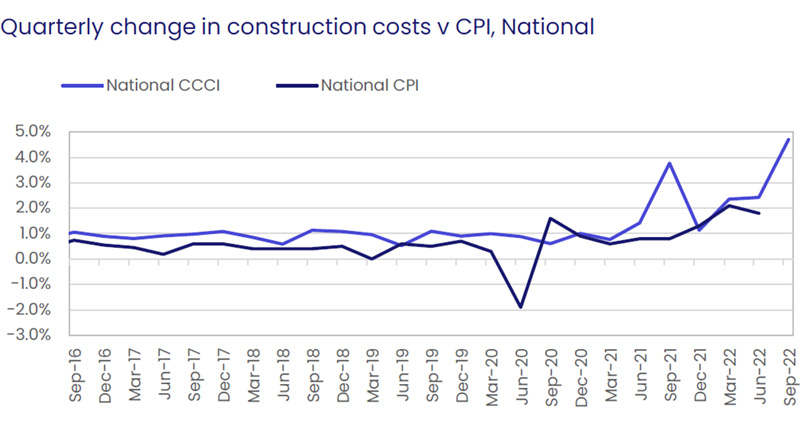Building cost blow outs continue with no end in sight
Construction costs have blown out to record levels and are having a massive impact on the embattled building industry.
Victoria and Queensland have led the surge in construction costs around the country, according to a new report.
Construction costs nationally have soared at around double the wider inflation rate, rising by 11 per cent in the past 12 months and showing no signs of slowing.
The most recent Cordell Construction Cost Index (CCCI) showed the latest quarterly and annual increases were the largest on record (excluding an exceptional period impacted by the introduction of GST).
Victoria recorded the largest growth rate of all states, with residential construction costs increasing by 12.3 per cent over the 12 months to September 2022. Queensland’s 5.8 per cent cost hike was the country’s highest quarterly gain.
Residential construction costs rose by a further 4.7 per cent nationally over the three months to September, compared to 2.4 per cent over the June quarter and 3.8 per cent over the September 2021 quarter. Annually, the CCCI increased by 11.0 per cent over the 12 months to September 2022, compared to 10.0 per cent over the 12 months to June 2022 and 7.1 per cent over the 12 months to September 2021.
Looking at the individual states over the three months to September, New South Wales (4.0 per cent), Victoria (5.6 per cent) and Queensland (5.8 per cent) all recorded their largest quarterly growth rates in residential construction costs since the introduction of GST in 2000. Western Australia (3.3 per cent) and South Australia (4.4 per cent) recorded their second largest quarterly growth rates since 2000, with both states recording higher quarterly increases over the September 2021 quarter compared to now.
Doors to disposal
CoreLogic Construction Cost Estimation Manager, John Bennett, said costs continued to rise most across timber and metal materials, which was affecting framing and reinforcing.
“In particular we are recording significant volatility in pre-fabricated framing and the range of products affected by higher building material costs is only growing, with many suppliers having little choice but to pass on price increases,” he said.
“This quarter has also shown a larger increase in the cost of wall linings, including plasterboard and fibre cement, which previously had been relatively stable.
“It will cost you more to get into your house too, with the price of doors showing a sharp rise in the last quarter.”

Source: CoreLogic.
Mr Bennett said while some suppliers have noted a stabilisation in sea freight prices it was the increasing cost of raw materials, labour and fuel that continued to place upwards pressure on residential construction costs.
“We’re also seeing this flow into other sectors, such as a large increase in waste disposal fees across most states, and volatility in professional fees and services, with Victoria and Queensland showing the highest cost increases,” he said.
Mr Bennett said the industry is facing significant additional challenges each quarter, with suppliers having dealt with the impact of rising fuel, freight and electricity to their bottom line for more than 18 months.
“A shortage of labour and more expensive overheads continue to have a bearing on the industry and its impact on the residential construction industry has not been lost with ongoing delays to completion times and a blow out to builders holding costs during a period of market change.”
Tim Lawless, Research Director at CoreLogic, said while the rising cost of construction was not new, the persistent increase in construction costs would continue to have a big impact nationally.
“This is an industry facing tough workload pressures against a backdrop of low labour supply, material shortages, rising interest rates and inflationary pressures,” Mr Lawless said.
“This new high in the cost of construction flows through to margins, unexpected costs for consumers and potentially lengthy delays to home owners who are waiting on the sidelines, often in rental or short-term accommodation, for the completion or possibly the start of their project.
“We also forget the impact to existing home owners and the insurance industry, as they struggle to reassess existing policies in a timely manner to make sure they are adequately covered in the event they need to make a claim.”
The profitless boom
Mr Lawless said ongoing labour shortages and supply issues meant it was likely conditions in the construction industry would remain challenging with little reprieve expected in the short to medium-term.
“The backlog of construction approved during Covid is still being worked through and on top of that is the rebuild and repair work following this year’s major weather events, with more forecast this month,” he said.
“The demand and pressure for construction materials and trades is expected to continue.
“There’s no quick solution for providing additional materials and fuel costs remain elevated.
“All of these factors have an impact and are likely to push building costs higher for some time yet.”
“Persistently high construction costs are clearly adding to inflationary pressures as well, with the price of new dwellings one of the most significant contributors to the June quarter inflation reading,” Mr Lawless said.
REIQ chief executive Antonia Mercorella told media she was concerned about the number of builders going bust, which she said was most prolific in Queensland.
“(Builders) were locked into fixed-prices contracts, and material costs rose,” she said.
“So it is hard to make money in what we are calling a ‘profitless construction boom’.
“We should all be incredibly concerned when we see very established builders going bust.
“Most builders now won’t do fixed-price contracts and banks only want to lend if it is a fixed price, so it’s a very difficult situation.”




















